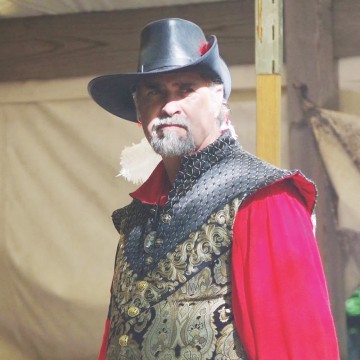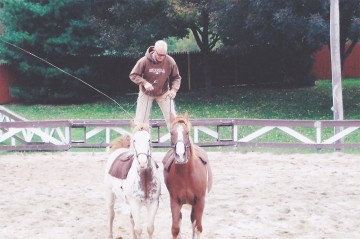A Fair of Many Faces
They are bedraggled hermits, shouting village sheriffs, enchanting shopkeepers and battle-worn knights. They are crowned, jolly kings and gallivanting princesses and run-down peasant rabblers.
Other times of the year, they are people with everyday lives. During this special season, however, they shapeshift into magical time travelers intent on bringing you with them at the 27-acre Renaissance Festival in Crownsville.
With a brand new storyline and a few new tricks, the 43rd Maryland Renaissance Festival promises a fresh historic experience, cultivated by more than 100 performers and professional actors.
The performers — who must be professional actors no younger than 18 — rehearse six days a week for two months in advance of the season. They earn their roles through highly competitive auditions where they must improvise on stage and recite a Shakespearian monologue.
Joining them in reviving history are battle-trained jousting knights and hard-working crafters.
From street performers to on-stage actors and Renaissance shopkeepers, these role-playing characters are the festival’s life force, said Carolyn Spedden, the artistic director for the Renaissance Festival.
“They are the show,” she said. “Renaissance festivals depend on people to provide the entertainment. Having high-quality and interactive performers is vitally important to its success.”
King Henry VIII
With a hearty laugh and a nearly drunken swagger, the king sways through the festival, sometimes pausing for a photo with a kid shouting for a royal selfie.
King Henry VIII is played by an ordinary not-so-ordinary man. He is Fred Nelson, a government employee during the off-season, and a 17-year veteran of the Renaissance Fest during the tailing summer months.
Nelson had been an actor before 2002, performing in many professional plays throughout the region. After the former Henry’s death, Nelson auditioned and won the festival’s pivotal — and demanding — role.
“It is an incredible acting challenge, assuming a character from 10am to 7pm,” the king told me. “It’s a whole new ball of wax to be in improv all the time.”
It’s a role he’s come to love, rising each year to a new challenge.
This year, the plot thickens. As Henry exchanges Queen Catherine of Aragon for Lady Anne Boleyn, he travels to meet with the king of France to gain international approval for his new marriage.
In previous storylines Henry was jolly and oblivious. This year, Nelson plans to play a determined and relentless king. Before, the king was content with others ruling the kingdom. Now, he wants to run it himself.
To keep the whole festival in harmony with the story, the king and his subjects have developed two simple rules.
“Number 1: stay in character, all day,” Nelson said. “Rule Number 2, don’t ruin the magic.”
“A thousand things everyday” threaten to break those rules, Nelson said. But they never break character. The actors use code words to communicate if anything goes awry.
High among everyday challenges is the physical. The king’s garb is hot. Chance stumbles or bee stings are constant threats.
But bigger problems can come from within. Many performers return year after year, becoming their own tight-knit family. When the former king died in 2002 and Nelson joined, many were mourning their previous ruler. It was hard for them to accept a substitute, until Nelson broke the ice with a letter.
“The floodwaters opened,” he said, “and they poured out their hearts.”

You can see Plott with a hunched back, scurrying across the grounds as a nasty hermit, or standing tall with sword in hand and scabbard swinging across his hip, shouting commands or brawling on stage as the sheriff.
Veterans like Plott are familiar faces for festival regulars, Plott said. Many guests recognize him throughout his various roles, which keeps them laughing.
Still, Plott said their improv characters create a unique show every day for festival-goers — and also for the actors.
“It’s one of the most difficult acting jobs an actor will ever have, but also one of the most fulfilling,” he said.
The festival is approaching its 50th year, so Spedden said she spices things up each time “to keep the festival fresh.”
There’s the brand new Company of Women, for example, performing an all-female Julius Caesar. The festival also has a new production of Romeo and Juliet, new street performers such as Magical Mystical Michael and a novel high-performance juggler.
The ultimate interaction comes on the huge jousting stage, where the Debracey Production knights prance on snorting horses, doing stunts and dodging lances.

Bill Durch created Debracey Productions for the Maryland Renaissance Festival in 2014. Now he has contracts around the world.
Durch’s company keeps 20 horses, 13 of them in Maryland, for feats from chariot racing to jousting.
“It’s full-contact jousting,” he said. “We hit pretty hard.”
Because it’s a dangerous sport, knights — expert riders before they pick up a lance — train weekly to create a high-stakes sporting performance for the audience.
Here too, every show is unique and unpredictable. The storylines also change to keep the audience on their toes. This year, instead of winning a princess’ hand, the four knights are competing to become generals of the king’s army.
“You won’t be able to predict our show,” Durch said. “We can’t predict it.”
From king and queen to sheriff, hermit and knights, from oldest to newest, these performers are putting on a show for you.
The Renaissance Festival has paved the way for interactive, guest-to-performer relationships in theme parks and fairs galore.
“When Renaissance festivals began nearly 50 years ago, that interactive element was rather unique,” Spedden said. “Here, they still welcome the patron to be part of the village of Revel Grove in 1532.”
